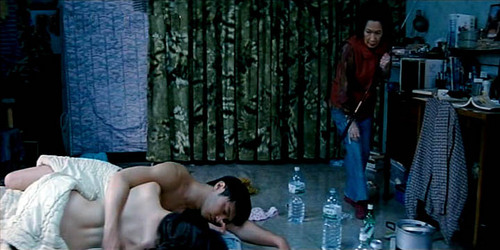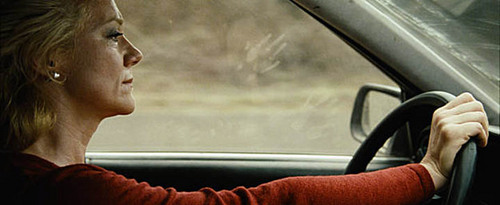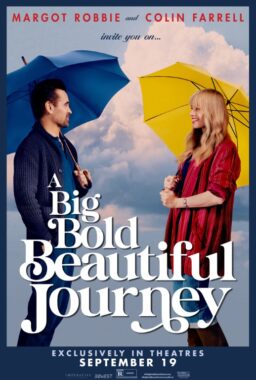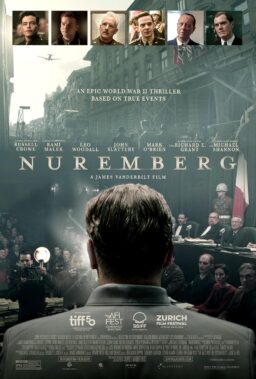Opening shot of the year: The acoustic guitar music plays over a company logo at the head of the film, before the movie proper. A woman in a purple brocade jacket and a blue skirt walks through a field of tall, brown grass. Percussion enters the picture — or the soundtrack. She looks us in the eye, and dances. (Joon-ho Bong’s “Mother” (2010))
Final shot of the year: In a group of people photographed through a pair of thick, smoked-glass doors, only the title character appears out of focus. (Lucrecia Martel’s “The Headless Woman”)
Seeing both these movies in one day certainly makes October 2 the highlight of my movie year so far. “The Headless Woman,” by the Argentinian director of “The Swamp” and “The Holy Girl,” is a kind of “Repulsion” in reverse. (With a little Oliver Sacks thrown in.) It takes place inside the concussed head of a woman who may or may not have run over a child on a stretch of dirt road near a canal.
An astonishing three-shot sequence begins with the locked-down camera observing her in profile from the passenger seat. A silly, upbeat ABBA-esque pop tune (“Soleil, soleil…”) fills the car. On the seat beside her, a cell phone rings. She fumbles to answer it, taking her eyes off the road. A horrible-sounding bump and she is propelled forward, hitting her head on the wheel, her sunglasses knocked off her face as she comes to a stop. Dust swirls outside and handprints are noticeable on the driver’s side window. She sits. She composes herself. The infernal music continues. She almost turns around to look, but does not. She moves to open the car door but does not. Eventually, she accelerates. Cut to: A rear view. Receding in the distance is the body of a dog on the roadside — a dog we have seen playing with three boys in the film’s opening sequence. Cut to: Another angle from the front seat. The woman stops the car, gets out, leaving the door open. She walks out of the frame to the right, then through it and out of the frame to the left, then back again. Through the windshield we see her body, but not her head. One by one, big drops of rain start to fall on the glass.

The typical shot in “The Headless Woman” is a close-up or medium shot of Verónica (Maria Onetto) with the most important action occurring off-screen, seeping into our awareness through the layered buzzing and ringing ambience on the soundtrack, or out of focus in the background. Veró spends the early part of the film in a daze and barely speaking. As she begins to collect her wits, and her memory, she attempts to piece together what happened — even as others around her try to protect her from… what? The truth? Suspicion? Herself?

There are no cutaways or inserts where you expect them to be — and for that I am most grateful, because it allows us to piece together what we’re experiencing indirectly, not precisely from Veró’s POV (though we spend a lot of time looking over her shoulder), but at one remove from hers, which is one step removed from reality. The car itself, with its array of window-frames, becomes a metaphor for Verónica’s psyche, fragmented and sealed off from the world outside even while passing through it. Martel’s direction suggests far more than she shows, leaving us as disoriented and uncertain as Veró. When Veró reads a disturbing item in the paper, we see only her face and the gardener behind her, tapping stakes into the ground to uncover the dimensions of something — a long-buried basin, perhaps — impenetrable beneath the soil.
(Special pop quiz: Anybody recall who performed the 1971 pop hit “Mamy Blue“? Click on the title for the answer. See the movie for the reason behind the question.)
* * * *

Another film that insists you actually watch it is “Mother,” from the director of “Memories of Murder” and “The Host.” I’m told the Korean title is actually a pun that suggests both “mother” and “murder” — and that is how it should be, as this is a Hitchockian murder mystery, rife with sexual overtones, and characterized by those quicksilver shifts of tone that are Bong Joon-ho’s hallmark. Comedy, thriller, melodrama, surreal dream… Not unlike “The Headless Woman,” the movie is at least partially filtered through a dazed consciousness — in this case, a developmentally retarded (but don’t call him “retard”!) 27-year-old young man named Do-Joon (Won Bin) who still sleeps with his ferociously devoted mother, Hye-Ja (Kim Hye-Ja). When Do-Joon is arrested for murder (only Bong would combine that moment with a stunning car wreck and then play it for comedy), mother will not rest until she gets to the bottom of what really happened.
“Mother” is a tangle of twists, digressions and dead ends — directed with such wit and visual imagination that it keeps you on your toes. One set-piece involves a significant golf club, a woman hiding in a curtained closet, a couple having sex and then napping on a mattress only a few feet away, and an obstacle course of water bottles between the closet and the exit. Hitchcock would have howled with delight. I did, anyway, especially when the club emerges from between the curtains like a stiff-necked cobra. We won’t even mention another shot of a hand-carried white plate with two cherry tomatoes rolling around on it and the two inactive black chopsticks beside them. Oh, what the heck — it’s so marvelous, let’s mention it.
“Mother” also presents a strong contender for final shot of the year, another dance that becomes a frenzied play of light and shadow. Both these movies had me smiling in the dark and saying “wow” to myself again and again. Not because they hit me in the face with anything spectacular but because the intelligence apparent in every frame is electrifying to behold. This is what makes going to the movies fun.

Above: Detective Mother attempts to exit unobtrusively, clutching a crucial piece of evidence. Below: Mother tries to get through to her boy.












